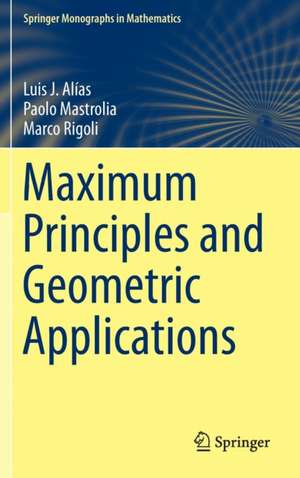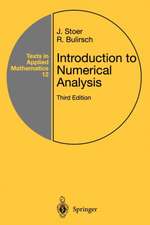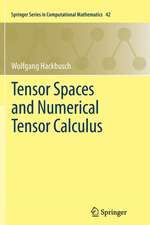Maximum Principles and Geometric Applications: Springer Monographs in Mathematics
Autor Luis J. Alías, Paolo Mastrolia, Marco Rigolien Limba Engleză Hardback – 22 feb 2016
This monograph presents an introduction to some geometric and analytic aspects of the maximum principle. In doing so, it analyses with great detail the mathematical tools and geometric foundations needed to develop the various new forms that are presented in the first chapters of the book. In particular, a generalization of the Omori-Yau maximum principle to a wide class of differential operators is given, as well as a corresponding weak maximum principle and its equivalent open form and parabolicity as a special stronger formulation of the latter.
In the second part, the attention focuses on a wide range of applications, mainly to geometric problems, but also on some analytic (especially PDEs) questions including: the geometry of submanifolds, hypersurfaces in Riemannian and Lorentzian targets, Ricci solitons, Liouville theorems, uniqueness of solutions of Lichnerowicz-type PDEs and so on.
Maximum Principles and Geometric Applications is written in an easy style making it accessible to beginners. The reader is guided with a detailed presentation of some topics of Riemannian geometry that are usually not covered in textbooks. Furthermore, many of the results and even proofs of known results are new and lead to the frontiers of a contemporary and active field of research.
| Toate formatele și edițiile | Preț | Express |
|---|---|---|
| Paperback (1) | 907.14 lei 6-8 săpt. | |
| Springer International Publishing – 21 mar 2019 | 907.14 lei 6-8 săpt. | |
| Hardback (1) | 1229.24 lei 6-8 săpt. | |
| Springer International Publishing – 22 feb 2016 | 1229.24 lei 6-8 săpt. |
Din seria Springer Monographs in Mathematics
- 20%
 Preț: 818.27 lei
Preț: 818.27 lei - 15%
 Preț: 607.33 lei
Preț: 607.33 lei - 20%
 Preț: 574.69 lei
Preț: 574.69 lei - 18%
 Preț: 753.21 lei
Preț: 753.21 lei - 24%
 Preț: 740.02 lei
Preț: 740.02 lei - 18%
 Preț: 1234.77 lei
Preț: 1234.77 lei - 18%
 Preț: 969.93 lei
Preț: 969.93 lei - 24%
 Preț: 777.43 lei
Preț: 777.43 lei - 20%
 Preț: 758.01 lei
Preț: 758.01 lei - 24%
 Preț: 1598.57 lei
Preț: 1598.57 lei - 15%
 Preț: 650.86 lei
Preț: 650.86 lei -
 Preț: 396.40 lei
Preț: 396.40 lei - 18%
 Preț: 793.14 lei
Preț: 793.14 lei - 15%
 Preț: 499.77 lei
Preț: 499.77 lei - 18%
 Preț: 1236.19 lei
Preț: 1236.19 lei -
 Preț: 391.61 lei
Preț: 391.61 lei - 18%
 Preț: 1404.30 lei
Preț: 1404.30 lei - 18%
 Preț: 797.24 lei
Preț: 797.24 lei - 18%
 Preț: 916.25 lei
Preț: 916.25 lei -
 Preț: 397.01 lei
Preț: 397.01 lei - 15%
 Preț: 657.25 lei
Preț: 657.25 lei - 15%
 Preț: 467.79 lei
Preț: 467.79 lei - 15%
 Preț: 648.05 lei
Preț: 648.05 lei -
 Preț: 406.25 lei
Preț: 406.25 lei -
 Preț: 389.88 lei
Preț: 389.88 lei - 18%
 Preț: 986.01 lei
Preț: 986.01 lei - 15%
 Preț: 649.54 lei
Preț: 649.54 lei - 15%
 Preț: 581.14 lei
Preț: 581.14 lei - 15%
 Preț: 643.48 lei
Preț: 643.48 lei - 15%
 Preț: 647.73 lei
Preț: 647.73 lei - 18%
 Preț: 902.55 lei
Preț: 902.55 lei - 15%
 Preț: 653.33 lei
Preț: 653.33 lei - 18%
 Preț: 901.88 lei
Preț: 901.88 lei - 18%
 Preț: 907.27 lei
Preț: 907.27 lei - 18%
 Preț: 893.53 lei
Preț: 893.53 lei - 15%
 Preț: 659.53 lei
Preț: 659.53 lei - 18%
 Preț: 802.28 lei
Preț: 802.28 lei - 15%
 Preț: 661.32 lei
Preț: 661.32 lei - 15%
 Preț: 646.62 lei
Preț: 646.62 lei -
 Preț: 384.48 lei
Preț: 384.48 lei - 15%
 Preț: 704.36 lei
Preț: 704.36 lei - 18%
 Preț: 1248.20 lei
Preț: 1248.20 lei - 18%
 Preț: 1031.17 lei
Preț: 1031.17 lei -
 Preț: 409.13 lei
Preț: 409.13 lei - 15%
 Preț: 640.37 lei
Preț: 640.37 lei - 15%
 Preț: 643.34 lei
Preț: 643.34 lei -
 Preț: 388.72 lei
Preț: 388.72 lei - 18%
 Preț: 965.34 lei
Preț: 965.34 lei - 15%
 Preț: 648.89 lei
Preț: 648.89 lei - 15%
 Preț: 651.34 lei
Preț: 651.34 lei
Preț: 1229.24 lei
Preț vechi: 1499.06 lei
-18% Nou
Puncte Express: 1844
Preț estimativ în valută:
235.24€ • 245.29$ • 195.51£
235.24€ • 245.29$ • 195.51£
Carte tipărită la comandă
Livrare economică 21 martie-04 aprilie
Preluare comenzi: 021 569.72.76
Specificații
ISBN-13: 9783319243351
ISBN-10: 3319243357
Pagini: 570
Ilustrații: XXVII, 570 p.
Dimensiuni: 155 x 235 x 33 mm
Greutate: 10.17 kg
Ediția:1st ed. 2016
Editura: Springer International Publishing
Colecția Springer
Seria Springer Monographs in Mathematics
Locul publicării:Cham, Switzerland
ISBN-10: 3319243357
Pagini: 570
Ilustrații: XXVII, 570 p.
Dimensiuni: 155 x 235 x 33 mm
Greutate: 10.17 kg
Ediția:1st ed. 2016
Editura: Springer International Publishing
Colecția Springer
Seria Springer Monographs in Mathematics
Locul publicării:Cham, Switzerland
Public țintă
ResearchCuprins
A crash course in Riemannian geometry.- The Omori-Yau maximum principle.- New forms of the maximum principle.- Sufficient conditions for the validity of the weak maximum principle.- Miscellany results for submanifolds.- Applications to hypersurfaces.- Hypersurfaces in warped products.- Applications to Ricci Solitons.- Spacelike hypersurfaces in Lorentzian spacetimes.
Recenzii
“This is a very well-written book on an active area of research appealing to geometers and analysts alike, whether they are specialists in the field, or they simply desire to learn the techniques. Moreover, the applications included in this volume encompass a variety of directions with an accent on the geometry of hypersurfaces, while the high number of references dating from 2000 or later are a testimonial of the state of the art developments presented in this volume.” (Alina Stancu, zbMATH 1346.58001, 2016)
Textul de pe ultima copertă
This monograph presents an introduction to some geometric and analytic aspects of the maximum principle. In doing so, it analyses with great detail the mathematical tools and geometric foundations needed to develop the various new forms that are presented in the first chapters of the book. In particular, a generalization of the Omori-Yau maximum principle to a wide class of differential operators is given, as well as a corresponding weak maximum principle and its equivalent open form and parabolicity as a special stronger formulation of the latter.
In the second part, the attention focuses on a wide range of applications, mainly to geometric problems, but also on some analytic (especially PDEs) questions including: the geometry of submanifolds, hypersurfaces in Riemannian and Lorentzian targets, Ricci solitons, Liouville theorems, uniqueness of solutions of Lichnerowicz-type PDEs and so on.
Maximum Principles and Geometric Applications is written in an easy style making it accessible to beginners. The reader is guided with a detailed presentation of some topics of Riemannian geometry that are usually not covered in textbooks. Furthermore, many of the results and even proofs of known results are new and lead to the frontiers of a contemporary and active field of research.
Caracteristici
Provides a self-contained approach to the study of geometric and analytic aspects of maximum principles, making it a perfect companion to other books on the subject
Presents the essential analytic tools and the geometric foundations needed to understand maximum principles and their geometric applications
Includes a wide range of applications of maximum principles to different geometric problems, including some topics that are rare in current literature such as Ricci solitons
Relevant to other areas of mathematics, namely, partial differential equations on manifolds, calculus of variations, and probabilistic potential theory
Descriere
This monograph presents an introduction to some geometric and analytic aspects of the maximum principle. In doing so, it analyses with great detail the mathematical tools and geometric foundations needed to develop the various new forms that are presented in the first chapters of the book. In particular, a generalization of the Omori-Yau maximum principle to a wide class of differential operators is given, as well as a corresponding weak maximum principle and its equivalent open form and parabolicity as a special stronger formulation of the latter.
In the second part, the attention focuses on a wide range of applications, mainly to geometric problems, but also on some analytic (especially PDEs) questions including: the geometry of submanifolds, hypersurfaces in Riemannian and Lorentzian targets, Ricci solitons, Liouville theorems, uniqueness of solutions of Lichnerowicz-type PDEs and so on.
Maximum Principles and Geometric Applications is written in an easy style making it accessible to beginners. The reader is guided with a detailed presentation of some topics of Riemannian geometry that are usually not covered in textbooks. Furthermore, many of the results and even proofs of known results are new and lead to the frontiers of a contemporary and active field of research.














